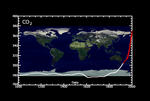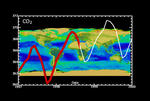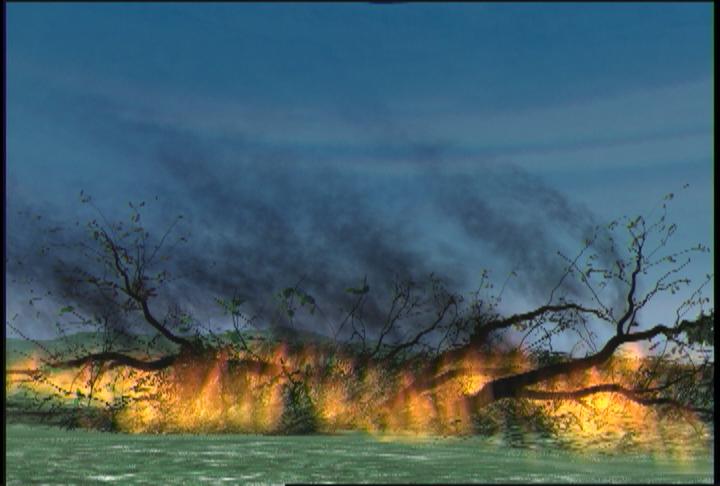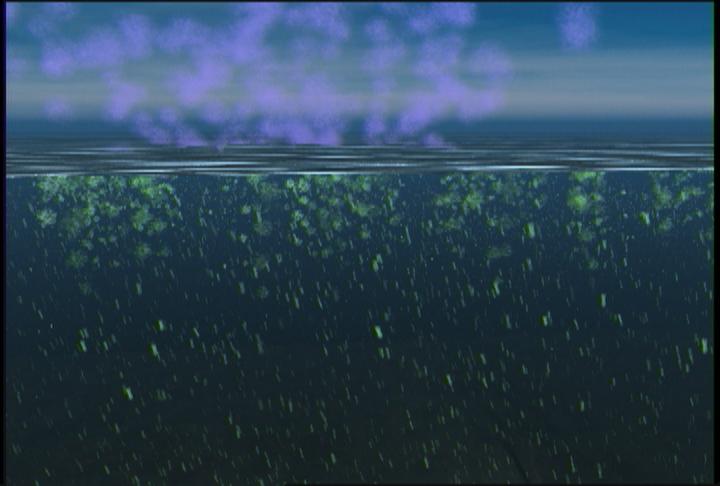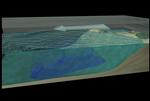The Colors of Life, The Colors of the World - Page One
A Palette of Colors, A Planet Revealed - Page Three
THE CARBON CYCLE
Note: There are numerous images and animations contained on this page. This may result in longer download times. All SeaWiFS visualization courtesy: NASA/GSFC and ORBIMAGE
Click on each pic to enlarge
Click here for TIFF of left image
Click here for TIFF of middle image
Click here for TIFF of right image
THE CARBON RECORD, PAST AND PRESENT
Quantifying carbon as it moves through the biosphere has been a goal for a long time. For years, scientists have at least known that there’s an annual rhythm to the cycle of carbon uptake and release. As the seasons change like the beat of a silent, age old drum, carbon finds its way both into and out of living things around the world.
Using a variety of analytic techniques, researchers have been able to show that average levels of atmospheric carbon didn’t significantly change for thousands of years. But with the global phenomenon of urbanization in the latter half of the second millennium, particularly marked by the industrial revolution in the nineteenth century, ambient carbon levels in the atmosphere started rising.
Of late they’re rising faster than ever.
In this visualization, we see a graph showing ambient atmospheric carbon going back roughly a thousand years. Data for the graph prior to the sharp rise comes from ice core samples collected in Antarctica. This is considered the preferred method for determining historic atmospheric carbon dioxide levels.
But since 1958, researchers working at a field station near the Mauna Loa caldera in Hawaii have collected data about ambient carbon dioxide levels once an hour. Their findings, daily averages constituting the longest continuous record of atmospheric carbon dioxide in the world, are powerful.
Since they began tracking it, the record of ambient atmospheric carbon dioxide shows a steady increase, year after year. In fact, the Mauna Loa record shows a 16.6% increase in the mean annual concentration, rising from 315.83 ppmv (parts per million by volume) of dry air in 1959 to 368.37 ppmv in 1999. Between 1997 and 1998, the record shows the single largest one-year increase: 2.9 ppmv.
But the Mauna Loa record also validates something else significant, shown here in the visualization. There’s an annual pulse to the presence of carbon, coinciding with seasonal variations. That oscillation not only marks the heartbeat of the cycle, but also gives researchers a point of reference for future study into how the cycle may be changing. As we look at the last three years of data gathered by SeaWiFS, we clearly see not only that seasonal variation, but also a steady, inexorable rise in ambient atmospheric carbon.
CARBON AND THE LAND – THE FAST CYCLE
Many of us actually experience a side effect of the carbon cycle in our lower backs every autumn. Leaves fall from the trees, and out we go with rakes and wheelbarrows to whisk them away.
Those thousands of curled brown bits of trees that flutter to the ground are packets of carbon, recycling naturally if we didn’t sweep them up. During the spring and summer, terrestrial plant life drinks carbon dioxide in from the atmosphere and, combined with water and nutrients from the soil, grows. This is called carbon sequestration—carbon being taken in from the surrounding world and literally trapped for a period of time by the very body that it enables to grow.
The growing season pulls carbon out of the air and converts its into building materials. But in the fall and winter, significant parts of that growth die off, and that carbon goes back into system, churned up by the fast (by planetary standards) process of decomposition.
Another way that carbon recycles following the terrestrial growth process begins when the natural life of a plant ends. When a tree, for example, ultimately dies and begins to decompose, all of the carbon sequestered in its trunk and branches and roots begins the cyclic process of passing back into the environment.
Fire can accelerate this process, sending plumes of carbon-laden aerosols into the atmosphere, as well as leaving carbon-rich ash deposits on the ground for further decomposition and recycling.
CARBON AND THE OCEAN – THE SLOW CYCLE
The oceans are vast, and their processes as complex as their waters are deep. In terms of the carbon cycle, the process moves at a much slower pace than on land, but its implications are just as significant, if not more so.
Tiny single celled plant life called phytoplankton absorb carbon dioxide from the atmosphere and nutrient rich waters and grow in wide colonies called blooms. These blooms are highly variable in their nature; their size and intensity are significantly dependent on surrounding environmental conditions.
Nutrient rich waters can come from a variety of places. Two of the most easily identified are deep-water upwellings and outflows from rivers. As phytoplankton grows, it forms the foundation for the food chain, thus passing carbon up to higher life forms.
But just as on land, links in the ocean’s chain of life also break, and stored carbon settles out of the top layers of water. A portion of it gets swept back to the surface as upwellings, only to begin again, but a major portion sinks to the bottom, becoming what oceanographers call "marine snow". This decomposing biological matter literally precipitates through the water and builds up on the ocean bottom, essentially sequestered from the rest of the Earth for geologically long periods of time.
DEEP WATER FEAST: UPWELLINGS BRING NUTRIENTS TO THE SURFACE
Like any other life form, phytoplankton requires nutrients to grow. In the ocean, those nutrients are often found in cold, deep water. Large phytoplankton blooms tend to coincide with natural phenomena that drive that nutrient rich water to the surface. The process is called upwelling, and it happens in a couple of different ways.
The principle mechanism by which deep, cold, and nutrient rich water rises up through the water column can be found along the western coasts of the continents. Or, said more specifically, upwellings often take place along the eastern margins of oceanic basins. Here’s what’s happening: winds coming off principal land masses push surface layers of water away from the shore. Into the resulting wind-driven void deeper water underneath the surface layers rushes in toward the coast, bringing with it nutrients for life to bloom.
The process is largely governed by the rotation of the planet, essentially sloshing the waters and winds of the world in one dominant direction.
Exceptions to this, however, can be found in the Indian Ocean, where unique monsoon related weather patterns churn the ocean currents enough to create coastal upwelling patterns along other coasts. Also, in the equatorial Pacific Ocean, one of the largest examples of deep water upwelling can be seen. Although primarily due to process of surface water being pushed out of the way, allowing deeper water to rush in like we see along coasts, the process of surface water removal in the Pacific is somewhat different.
On the equator, water currents on either side of the hemispheric dividing line are generally moving in opposite directions—again due to planetary rotation and the Coriolis effect. As those currents rush past each other they ostensibly "peel back" the surface of the ocean, creating a void for deeper water to rush in and take its place.
Click
here for Page Three
Last Updated 03/27/01
[ back to top | email
us | GSFC Home ]
